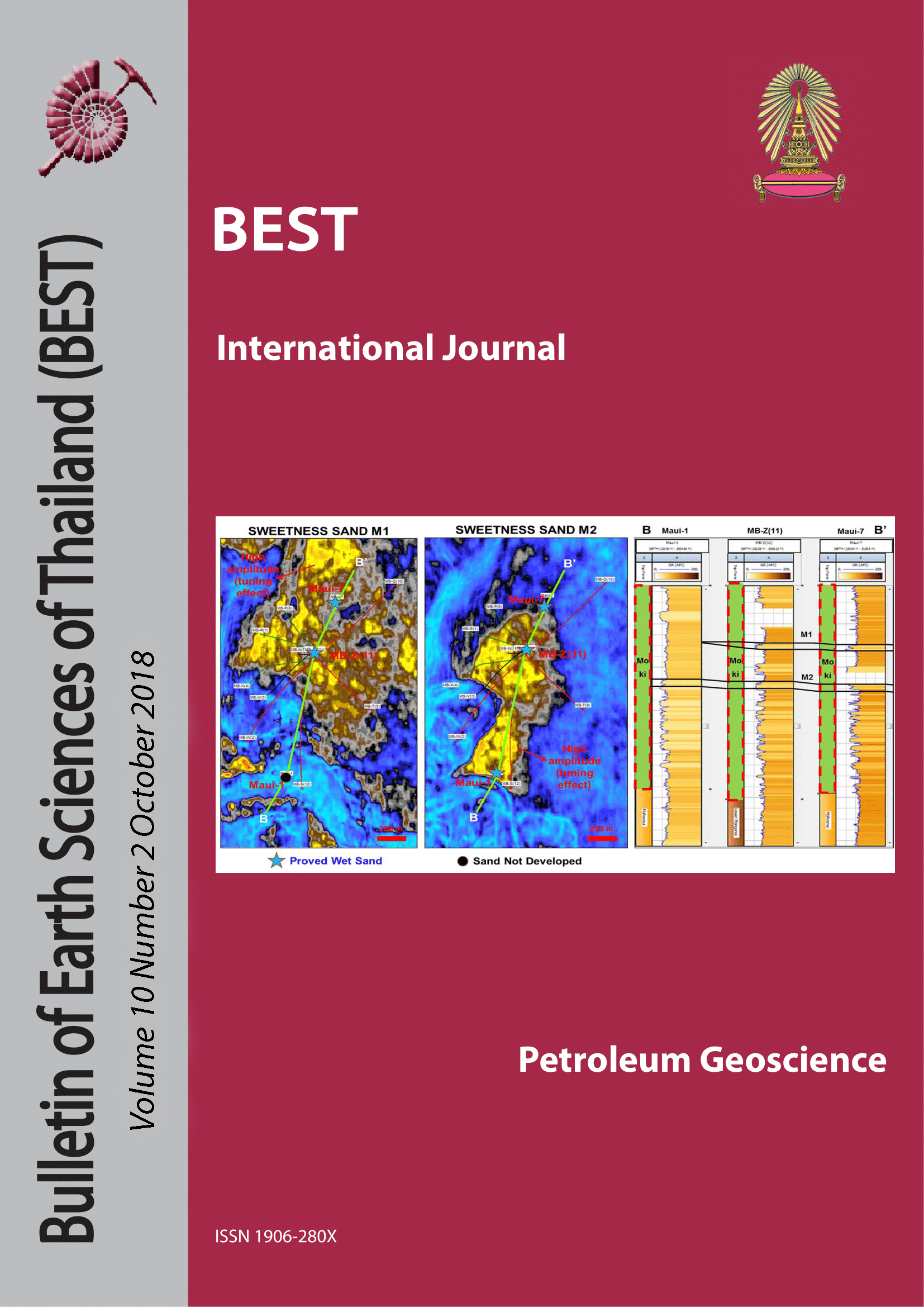Fluid Evolution of Permian Carbonates in Muak Lek District, Saraburi province, Central Thailand: A Tectonically Driven Fluid System
Main Article Content
Abstract
The nature of deposition and diagenesis in carbonates of Central Thailand is not yet well documented and understood. This study focuses on an outcrop exposed in an active rock slab quarry in Central Thailand, extracting the Khao Kwang formation of the Saraburi Group. To quantify the depositional setting and diagenetic evolution of rocks in this area, especially related to levels of porosity and permeability modification, work was done via the integration of outcrop observations, petrography, X-ray powder diffraction (XRD) analysis, and carbon and oxygen stable isotope determinations.A unique giant bivalve (Alatoconchidae) and a characteristic fusulinid assemblage show the studied strata were deposited in the Middle Permian. Muddy lime sediments were deposited in a bioticallyrestricted, outer back-reef lagoon. The bottom sediments were occasionally reworked by storm events as evidenced by the frequent association of mud-dominated intraclastic limestones with un-layered fusulinid aggregates. Floatstone and rudstone are the dominant rock types defined at the field scale, while at the microscale the same rocks classify as grain-dominant wackestone and packstone. The δ13CPDB and δ18OPDB values plot into two groups in a C-O covariance plot; 1) A trend of positive carbon value from (0 to +6.1‰) versus more negative oxygen values (-4.7 to -16.7‰), and 2) A trend of increasingly negative carbon (-10.5 to -11.3‰) and oxygen values (-6.6 to -12.8‰). The more negative carbon and oxygen values show that precipitated calcites were bathed by subsurface waters driving refractionation and re-equili-bration under the influence of increasingly warmer burial fluids. By the moderate mesogenetic stage (with its pervasive pressure solution) carbonate sediments and bioclast pores were largely cemented. In addition, any remnant porosity was continually reduced though cementation along open fractures, which were filled with equant-shaped syntaxial vein calcites. Then, after more than 200 million years in the mesogenetic realm (since the Triassic), the distal effects of Himalayan Orogeny uplifted the Saraburi Group sediments. These limestones once again experienced active phreatic circulation as they entered the zone of telogenesis and karstification, with the associated development of enhanced levels of secondary porosity. However, a terra rossa soil was transported and deposited inside many of the vugs and solution channels, via infiltration of meteoric water; this resulted in a reduction of this newly formed karstic porosity.To summarise, this Permian limestone has a low chance of becoming a reservoir unless the overprinting effects of telogenetic groundwaters can be preserved. These overprints tend to erode the limestone, creating vugs and solution enhanced fissures and can also drive dedolomitisation.
Article Details

This work is licensed under a Creative Commons Attribution-NonCommercial-NoDerivatives 4.0 International License.
Copyright © 2008 Department of Geology, Faculty of Science, Chulalongkorn University. Parts of an article can be photocopied or reproduced without prior written permission from the author(s), but due acknowledgments should be stated or cited accordingly.
References
Ahr, W.M. (2008). Geology of Carbonate Reservoirs: the Identification, Description, and Characterisation of Hydrocarbon Reservoirs in Carbonate Rocks. Wiley InterScience, Hoboken, N.J., p. 277.
Hitzman, M. W. (1999). Routine staining of drill core to determine carbonate mineralogy and distinguish carbonate alteration textures. Mineralium Deposita, 34(8), 794-798
Pomar, L., and P. Hallock, 2008, Carbonate factories: A conundrum in sedimentary geology. Earth- Science Reviews, v. 87, p. 134-169.
Warren,J., Morley, C. K., Charoentitirat, T., Cart wright, I., Ampaiwan, P., Khositchaisri, P., ... & Yingyuen, J. (2014). Structural and fluid evolution of Saraburi Group sedimentary carbonates, central Thailand: A tectonically driven fluid system. Marine and Petroleum Geology, 55, 100-121.


